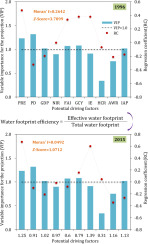当前位置:
X-MOL 学术
›
Sci. Total Environ.
›
论文详情
Our official English website, www.x-mol.net, welcomes your feedback! (Note: you will need to create a separate account there.)
Variation and driving mechanism analysis of water footprint efficiency in crop cultivation in China.
Science of the Total Environment ( IF 9.8 ) Pub Date : 2020-04-07 , DOI: 10.1016/j.scitotenv.2020.138537 Xinchun Cao 1 , Rui Shu 2 , Jie Ren 2 , Mengyang Wu 1 , Xuan Huang 2 , Xiangping Guo 1
Science of the Total Environment ( IF 9.8 ) Pub Date : 2020-04-07 , DOI: 10.1016/j.scitotenv.2020.138537 Xinchun Cao 1 , Rui Shu 2 , Jie Ren 2 , Mengyang Wu 1 , Xuan Huang 2 , Xiangping Guo 1
Affiliation

|
Water footprint regulation in agricultural production is of great significance to regional food, water and ecological sustainability. The spatial-temporal characteristics and driving mechanism of water footprint efficiency (WFE) in crop cultivation in China during 1996-2015 were analysed based on the quantification of the crop-water relationship. The results showed that China's total crop water footprint (TWF) was 1125.6 G m3, and the blue, green and grey components accounted for 24.4%, 57.4% and 18.2%, respectively. The national WFE was 0.681 and increased over time due to the improvement of agricultural technology. Spatial autocorrelation analysis showed that provinces with similar WFE values were clustered geographically and have gradually weakened since 2012. Provinces with a high WFE were concentrated in the southeast and northeast, and low-value provinces were distributed in the west of China. The main anthropogenic driving factors were the preliminary fertilizer application intensity (FAI) and population density (PD); however, these factors have been replaced by the irrigation efficiency (IE), agricultural water use ratio (AWR) and irrigation area proportion (IAP) in recent years. Specific regions should formulate water resource management policies according to their WFE performance, agricultural production scale and water resource endowment. The northeast should control crop cultivation and enhance the yield to solve water shortage problems, the central provinces should improve WFE, and the southern provinces should contribute to the promotion of national water use efficiency by expanding crop sowing and irrigation areas. This study provides a reference for water resource management in the context of social and environmental change.
更新日期:2020-04-08


























 京公网安备 11010802027423号
京公网安备 11010802027423号